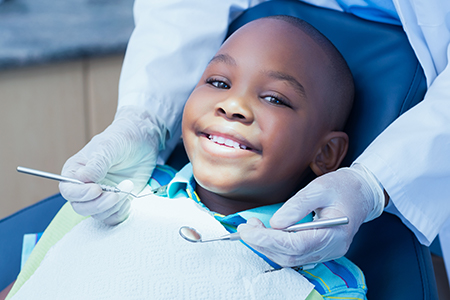
At Suss Dental Group, we prioritize the growth, comfort, and long-term oral health of every child who visits our practice. Our approach blends preventive care, family education, and gentle treatment so children build healthy habits and confident smiles that last a lifetime.

Healthy adult smiles begin with early care. Establishing routine dental visits and age-appropriate hygiene practices sets a predictable rhythm for a child's oral health. These early experiences shape both the physical development of teeth and a child's comfort with dental care, reducing anxiety and encouraging cooperation as treatments become more advanced.
Prevention is central to pediatric dentistry: timely cleanings, fluoride where appropriate, and targeted advice about diet and oral habits help reduce the risk of cavities and other common problems. Dentists also monitor growth and development so that small issues can be addressed early, when the simplest interventions are often the most effective.
Caregivers play a crucial role. Simple actions at home—brushing together, limiting sugary snacks, and modeling good oral hygiene—reinforce what children learn at the office. With consistent routines and clear guidance from the dental team, families can create an environment where healthy smiles and positive dental experiences thrive.

Routine visits are more than a quick look inside the mouth. A comprehensive pediatric exam assesses teeth, gums, jaw alignment, speech patterns, and oral habits. The dentist will review growth milestones, take a careful medical and dental history, and discuss any concerns parents may have about development or behavior.
Professional cleanings remove plaque and buildup that regular brushing can miss, helping to protect delicate enamel. During a visit, clinicians also provide age-tailored instruction so children can take on more responsibility for their daily care as they grow. Positive reinforcement and simple demonstrations make these lessons easy to follow.
When indicated, digital radiographs offer a safe, low-exposure way to see beneath the surface for early signs of decay, tooth positioning, or issues with jaw growth. Radiographs are used selectively, guided by the child’s age, clinical findings, and developmental needs to support the most informed, conservative care plan.
Tooth decay is one of the most common chronic conditions affecting children, but it is also highly preventable. Bacteria feed on sugars left on teeth and produce acids that erode enamel. Frequent exposure to sugary drinks or prolonged bottle use can accelerate this process, particularly in very young children whose enamel is still developing.
Parents can reduce risk by avoiding bedtime bottles filled with milk or juice, offering water instead, and starting daily cleaning routines as soon as the first teeth appear. Regular professional assessments identify early decay so it can be treated before it leads to pain, infection, or more extensive treatment.
When decay is detected, the goal is to restore function and comfort while preserving as much natural tooth structure as possible. Modern pediatric dental techniques emphasize minimally invasive approaches, prevention-focused follow-up, and practical guidance so families can prevent recurrence.
Start dental care early—clean gums after feedings and use a soft brush once teeth emerge.
Encourage twice-daily brushing with an age-appropriate toothpaste and supervise until children have the dexterity to brush effectively on their own.
Limit sugary snacks and replace sweetened beverages with water whenever possible to reduce acid attacks on enamel.
Keep regular checkups so the dental team can monitor development, apply preventive treatments like sealants when indicated, and offer personalized guidance.
Take steps to wean from pacifiers and discourage thumb-sucking at developmentally appropriate ages to avoid long-term bite changes.
Use a custom or well-fitted mouthguard for contact sports to protect teeth, lips, and jaws from injury.

Tooth development begins long before a baby’s first birthday, and the arrival of those first baby teeth is an important milestone. Dental organizations recommend a first dental visit around the time the first tooth appears or by the first birthday, whichever comes first. This early check provides reassurance and establishes a dental home for ongoing care.
Parents of infants can begin habits that set the stage for healthy growth: wipe gums after feedings, avoid putting a child to bed with a bottle containing anything other than water, and introduce an appropriately sized toothbrush as teeth erupt. These small routines help remove sugars and bacteria that lead to early decay.
Teething can be uncomfortable for babies and worrisome for parents. Gentle measures—such as chilled teething rings or a cool washcloth—often provide relief. If symptoms are severe or persistent, the dental team can offer targeted advice to keep the child comfortable while monitoring dental development.
As children move into elementary and middle school, their mouths change rapidly. Permanent teeth emerge, bite patterns evolve, and early orthodontic signs may appear. Regular monitoring helps identify issues that benefit from early intervention—often simpler and less invasive when caught early—so treatment plans can be timed for the best long-term outcomes.
Dental sealants are a common preventive option for school-age children once permanent molars erupt. Sealants provide a protective barrier on chewing surfaces where food and bacteria tend to accumulate, significantly lowering the risk of cavities in those hard-to-clean grooves.
Good nutrition continues to play a vital role. A balanced diet supports enamel strength and overall health, while limiting sticky and sugary snacks reduces decay risk. The dental team will work with families to create practical strategies that fit busy school schedules and snack routines.
Active children sometimes experience dental injuries—chipped teeth, knocked-out teeth, or soft tissue cuts—that require prompt, knowledgeable care. Understanding what to do immediately after an injury can preserve teeth and improve outcomes. The dental office can provide guidance on stabilizing a tooth, managing bleeding, and arranging urgent care when necessary.
Children with medical conditions, sensory sensitivities, or high anxiety around dental visits may need tailored approaches to treatment. The dental team can recommend strategies that make visits more manageable, including scheduling adaptations, behavior guidance techniques, and safe options to help children receive the care they need in a calm, supportive environment.
Emergency care and specialized support are delivered with a focus on safety and comfort. Whether the concern is an unexpected injury or a child who requires extra attention, timely, compassionate treatment helps restore oral health and prevent complications.
At Suss Dental Group, our goal is to partner with families to keep children’s smiles healthy and resilient through every stage of growth. If you would like more information about pediatric dental care, or guidance specific to your child’s needs, please contact us for additional details.

A pedodontist is a dentist who has received advanced specialty training in meeting the dental needs of children from infancy to adolescence. Pedodontists, also referred to as "pediatric dentists," study child psychology, behavior management, caring for children with special needs, methods of handling oral/facial trauma, and various techniques for providing anesthesia and sedation. Pedodontists also understand the complexities of facial growth and development and have the clinical skills required to meet the dental needs of all children at every stage of development. Most of all, pedodontists are passionate about what they do and enjoy working with children. They strive to make every dental experience a positive one as they help children establish a strong foundation for good oral health.
Even before your child is born, their first set of teeth is already forming. In fact, by one year of age, some of your baby's front teeth will have already come into place. While the arrival of your baby's first teeth is only one of many developmental milestones, it represents an excellent time to begin a program of oral care. According to recommendations from the American Dental Association, babies should see the dentist around the time of their first birthdays.
Your baby's first teeth typically begin to appear in the 6 to 12-month range. While this is an extraordinary milestone, you need to be aware that your baby may find the experience a little bit uncomfortable. Teething can make babies feel irritable. They may be fussy, have trouble sleeping, not want to eat, and drool quite a bit.
Although you are powerless to speed up the process of teething, there are a few things that you can do to soothe your baby as the new teeth are erupting into place. Common approaches to helping your baby feel more comfortable while getting new teeth, include teething rings or a cold spoon or moist gauze rubbed over their gums.
Even for these few new teeth, it's absolutely essential to establish an effective regimen of oral care. For information on when your baby's first set of teeth will erupt into place, consult this timeline from the American Dental Association: Eruption Charts
Some children persist in sucking their thumbs or fingers beyond their preschool years. For these children, the activity continues to be a source of comfort, relaxation, and security. It may even help them fall asleep at night. However, it's essential to be aware that in the long-term, a finger sucking habit is not healthy.
If your child's thumb or finger sucking habit is still present when the permanent teeth begin to come in, your child is at a higher risk of developing a bad bite. By the age of five or six years, you need to constructively and gently help your child stop the habit.
It's also a good idea to have a comprehensive evaluation at this time. Your pedodontist can assess if there are any habit related alterations to the alignment of your child's teeth or jaws, or if it is affecting their speech or swallowing patterns. They can also discuss habit control strategies with you, as well as follow your child's bite and facial development as they grow. If interceptive appliances or corrective orthodontic care are recommended, the timetable and best options in care will be explained in complete detail.
Dental organizations recommend a first visit around the time the first tooth appears or by the first birthday, whichever comes first. Early visits focus on prevention, establishing a dental home, and helping parents learn daily care techniques. These appointments are brief and designed to build familiarity so children feel comfortable with dental routines.
Starting early also allows the dental team to monitor growth and development and to identify any emerging concerns when treatment is simplest. A first visit creates a baseline for future care and helps set expectations for regular checkups. At Suss Dental Group we encourage families to schedule that initial visit to begin preventive care and education.
Good home habits are the foundation of cavity prevention: brush twice daily with an age-appropriate fluoride toothpaste, supervise brushing until children have the dexterity to brush effectively, and limit sugary snacks and drinks. Encouraging a balanced diet and replacing sweetened beverages with water reduces exposure to the sugars that feed decay-causing bacteria. Consistent routines and positive reinforcement make healthy habits more likely to stick.
Professional preventive care complements home efforts and includes routine cleanings, selective use of fluoride, and application of sealants when appropriate. Regular dental visits allow the team to identify risk factors and tailor preventive strategies to your child’s needs. Open communication with the dentist helps families address challenges and plan follow-up care focused on long-term oral health.
A routine pediatric exam evaluates teeth, gums, bite alignment, oral habits, and overall development while reviewing medical and dental history. The visit typically includes a professional cleaning to remove plaque and buildup followed by age-appropriate instruction to help children learn effective brushing and flossing. Clinicians use gentle techniques and positive reinforcement to make the experience comfortable and educational for both child and caregiver.
When clinically indicated, low-exposure digital radiographs may be taken to detect early decay or assess tooth positioning and jaw growth. The dentist will discuss findings, recommend preventive measures such as sealants or fluoride if needed, and create a personalized recall schedule. Clear guidance and follow-up planning ensure care is conservative and aligned with the child’s developmental stage.
Topical fluoride treatments applied in the dental office are safe and effective when used according to professional guidelines. Fluoride strengthens delicate enamel and helps reduce the risk of cavities, especially in children with higher decay risk or those with limited access to fluoridated water. The decision to recommend a fluoride application is based on the child’s age, oral health, and individual risk factors.
Parents should discuss their child’s fluoride exposure with the dentist so that in-office treatments and home use are balanced and appropriate. For many children, periodic topical applications during routine visits provide an extra layer of protection alongside daily fluoride toothpaste. The dental team will explain the benefits and answer questions to ensure families feel informed about preventive choices.
Dental sealants are thin protective coatings placed on the chewing surfaces of molars to block grooves where food and bacteria collect. They are commonly recommended once permanent molars erupt, typically for school-age children, because these teeth are at higher risk for cavities. Sealants are applied quickly and painlessly and can significantly reduce decay on vulnerable chewing surfaces.
The dentist evaluates each child’s cavity risk and timing to determine whether sealants are appropriate, and applications are often completed during a regular visit. Sealants are part of a broader preventive plan that includes good home care and routine checkups. The dental team will monitor sealants at follow-up visits and recommend reapplication if needed.
Teething can cause fussiness, drooling, and mild gum irritation as primary teeth erupt, and most babies find relief with soothing measures. Safe options include chilled (not frozen) teething rings, a cool washcloth to gnaw on, and gentle gum massage with a clean finger. Over-the-counter medications should be used only under pediatric guidance and for severe symptoms.
If teething symptoms are unusually severe, persistent, or accompanied by high fever or other concerning signs, parents should contact their pediatrician or dental team for advice. The dentist can also provide reassurance and check oral development during the child’s first visits. Early guidance helps families manage discomfort while monitoring healthy eruption patterns.
Remain calm and assess the situation quickly: control bleeding with gentle pressure, apply a cold compress to reduce swelling, and look for any tooth fragments or a knocked-out tooth. If a permanent tooth has been knocked out, place it in milk or saliva and seek immediate dental attention because prompt re-implantation may save the tooth. For broken or chipped teeth, preserve fragments and call the dentist for instructions about urgent care.
The dental office can advise whether immediate in-office care, same-day treatment, or emergency department evaluation is needed based on the injury. Timely professional assessment reduces the risk of infection and improves long-term outcomes for injured teeth and supporting tissues. Follow-up appointments help monitor healing and determine if additional restorative or preventive steps are necessary.
Dental teams use behavior guidance techniques such as tell-show-do, positive reinforcement, and gradual exposure to build trust and reduce anxiety for apprehensive children. Scheduling adjustments like morning appointments, extra time for acclimation, and a calm, child-friendly environment also help make visits predictable and less stressful. Clinicians work closely with caregivers to set expectations and reinforce coping skills at home.
For children with high anxiety or special needs, the dental team may recommend additional supports such as sedation options or coordinated care plans to ensure treatment can be delivered safely and comfortably. The approach is always individualized, focusing on safety, clear communication, and minimizing fear. Suss Dental Group emphasizes gentle, patient-centered strategies to help families navigate dental care with confidence.
Sucking is a normal soothing behavior for infants and young toddlers, but prolonged thumb-sucking or pacifier use can influence bite development and tooth alignment if it continues beyond the preschool years. Parents and caregivers should watch for signs of changes in the front teeth or jaw alignment and discuss timing for weaning with the dental team. Gentle, consistent guidance is usually effective when started at developmentally appropriate ages.
Strategies to reduce sucking habits include positive reinforcement, substitution with other comfort measures, and addressing triggers such as fatigue or boredom. The dentist can offer practical, age-appropriate techniques and monitor progress during routine visits. In cases where the habit persists and affects dental development, an individualized plan helps transition the child away from the behavior while protecting oral health.
Orthodontic readiness is monitored as permanent teeth erupt and bite relationships become clearer; signs that merit early evaluation include crowded or widely spaced teeth, crossbites, difficulty chewing, early or late loss of baby teeth, and noticeable jaw asymmetry. Early assessment allows the dentist to determine whether monitoring or timely intervention will produce simpler, more effective results. Routine pediatric dental visits are an opportunity to track growth and refer to an orthodontic specialist when appropriate.
When early or interceptive orthodontics is recommended, treatments are tailored to the child’s developmental stage and may guide jaw growth or create space for permanent teeth. Families can prepare by maintaining regular dental appointments, following preventive recommendations, and discussing timing and goals with the dental team. Collaborative care between the family, the general dentist, and an orthodontist helps achieve the best functional and aesthetic outcomes over time.

Ready to schedule your next dental appointment or have questions about our services?
Contacting Suss Dental Group is easy! Our friendly staff is available to assist you with scheduling appointments, answering inquiries about treatment options, and addressing any concerns you may have. Whether you prefer to give us a call, send us an email, or fill out our convenient online contact form, we're here to help. Don't wait to take the first step towards achieving the smile of your dreams – reach out to us today and discover the difference personalized dental care can make.